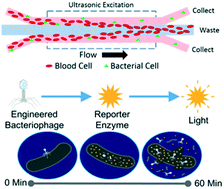Acoustic separation in plastic microfluidics for rapid detection of bacteria in blood using engineered bacteriophage†
Abstract
A more effective treatment of bacteremia requires a diagnostic platform that is both sensitive, accurate and rapid. Currently, clinical laboratory techniques require growth of bacteria prior to diagnosis, take days to complete, and leave empiric therapy and broad spectrum antibiotics as the only option at the onset of treatment. In order to bypass this growth requirement, we engineered a system that purifies bacteria from blood to improve performance in a bacteriophage-based luminescence assay. To perform the purification, we used acoustophoresis in plastic microfluidic chips, enabling future development into a low cost point-of-care system. Acoustophoresis achieves differential separation on the basis of size differences between bacteria and blood cells. We show isolation of three known pathogen species, including members of both Gram-negative and positive-bacteria from blood, and show isolation at clinically relevant concentrations. Using the device as a preparation step prior to the bacteriophage-based luminescence assay, we demonstrate a 33-fold improvement in limit of detection, compared with the unpurified sample, achieving a limit of detection of 6 bacteria.



 Please wait while we load your content...
Please wait while we load your content...